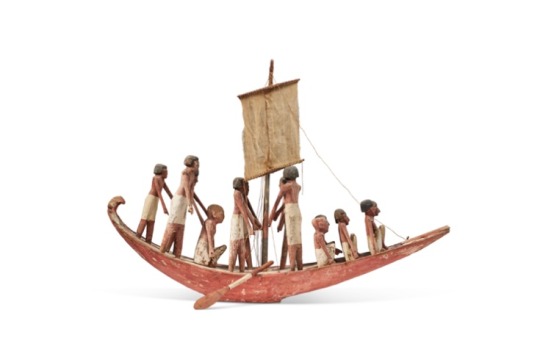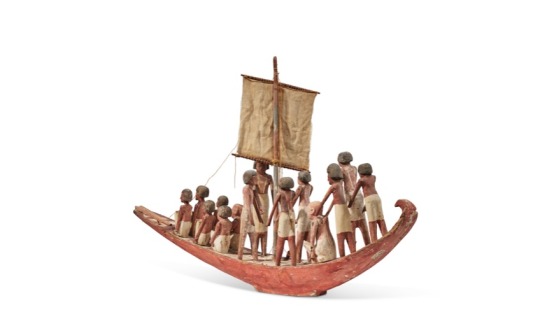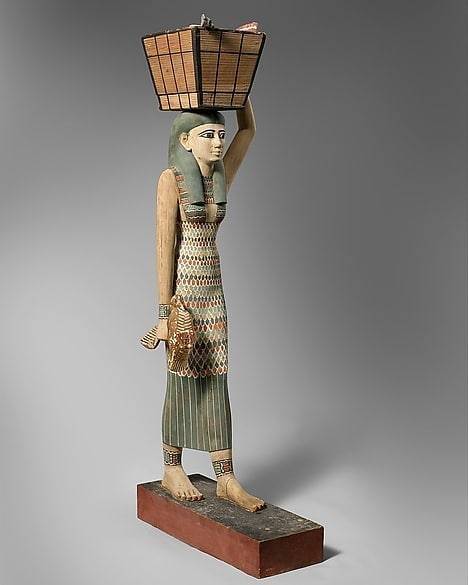#AN EGYPTIAN GESSO-PAINTED WOOD FUNERARY MODEL OF A BOAT
Text



AN EGYPTIAN GESSO-PAINTED WOOD FUNERARY MODEL OF A BOAT
MIDDLE KINGDOM, 11TH-12TH DYNASTY, 2087-1759 B.C.
#AN EGYPTIAN GESSO-PAINTED WOOD FUNERARY MODEL OF A BOAT#MIDDLE KINGDOM#11TH-12TH DYNASTY#2087-1759 B.C.#ancient artifacts#archeology#archeolgst#history#history news#ancient history#ancient culture#ancient civilizations#ancient egypt#egyptian history#egyptian mythology#egyptian art
408 notes
·
View notes
Photo

Estate Figure
Period: Middle Kingdom
Dynasty 12Reign: early reign of Amenemhat I
Date: ca. 1981–1975 B.C.
Geography: From Egypt, Upper Egypt, Thebes, S
Medium: Wood, gesso, paint
Dimensions: H. 112 cm (44 1/8 in.); W. 17 cm (6 11/16 in.); D. 46.7 cm (18 3/8 in.)
This masterpiece of Egyptian wood carving was discovered in a hidden chamber at the side of the passage leading into the rock cut tomb of the royal chief steward Meketre, who began his career under King Nebhepetre Mentuhotep II of Dynasty 11 and continued to serve successive kings into the early years of Dynasty 12. Together with a second, very similar female figure (now in the Egyptian Museum, Cairo) this statue flanked the group of twenty two models of gardens, workshops, boats, and a funeral procession that were crammed into the chamber's narrow space.
Striding forward with her left leg, the woman carries on her head a basket filled with cuts of meat. In her right hand she holds a live duck by its wings. The figure's iconography is well known from reliefs of the Old Kingdom in which rows of offering bearers were depicted. Place names were often written beside these figures identifying them as personifications of estates that would provide sustenance for the spirit of the tomb owner in perpetuity. The woman is richly adorned with jewelry and wears a dress decorated with a pattern of feathers, the kind of garment often associated with goddesses. Thus, this figure and its companion in Cairo may also be associated with the funerary goddesses Isis and Nephthys who are often depicted at the foot and head of coffins, protecting the deceased.
All the accessible rooms in the tomb of Meketre had been plundered in ancient times, but, early in 1920, the Museum's excavator, Herbert Winlock had his workmen clean out the accumulated debris in order to obtain an accurate floor plan of the tomb. It was during this cleaning operation that the small hidden chamber was discovered, filled with its almost perfectly preserved models and the two statues. In the division of finds between the Egyptian Government and the Metropolitan Museum, half of the contents went to the Egyptian Museum in Cairo, and half came to New York.
> metmuseum.org
89 notes
·
View notes
Photo

Statue of an Offering Bearer Period: MiddleKingdom Reign: early reign of Amenemhat IDate: ca. 1981–1975 B.C. Dimensions: h. 112 cm (44 1/8 in); w. 16.5 cm (6 1/2 in); d. 46.5 cm (18 5/16 in) Medium: Wood, gesso, paint This masterpiece of Egyptian wood carving was discovered in a hidden chamber at the side of the passage leading into the rock cut tomb of the royal chief steward Meketre, who began his career under King Nebhepetre Mentuhotep II of Dynasty 11 and continued to serve successive kings into the early years of Dynasty 12. Together with a second, very similar female figure (now in the Egyptian Museum, Cairo) this statue flanked the group of twenty two models of gardens, workshops, boats, and a funeral procession that were crammed into the chamber's narrow space. Striding forward with her left leg, the woman carries on her head a basket filled with cuts of meat. In her right hand she holds a live duck by its wings. The figure's iconography is well known from reliefs of the Old Kingdom in which rows of offering bearers were depicted. Place names were often written beside these figures identifying them as personifications of estates that would provide sustenance for the spirit of the tomb owner in perpetuity. The woman is richly adorned with jewelry and wears a dress decorated with a pattern of feathers, the kind of garment often associated with goddesses. Thus, this figure and its companion in Cairo may also be associated with the funerary goddesses Isis and Nephthys who are often depicted at the foot and head of coffins, protecting the deceased. All the accessible rooms in the tomb of Meketre had been plundered in ancient times, but, early in 1920, the Museum's excavator, Herbert Winlock had his workmen clean out the accumulated debris in order to obtain an accurate floor plan of the tomb. It was during this cleaning operation that the small hidden chamber was discovered, filled with its almost perfectly preserved models and the two statues. In the division of finds between the Egyptian Government and the Metropolitan Museum, half of the contents went to the Egyptian Museum in Cairo, and half came to New York. #BritishMuseum #egyptianmuseum (at The Metropolitan Museum of Art, New York) https://www.instagram.com/p/B_ZfwjvBmsF/?igshid=pb93i9oday18
0 notes